Fig. 2.1
Vertical jumps. (a) Landing phase. (b) Jump phase. Reproduced with permission from “The ACL Solution: Prevention and Recovery for Sports’ Most Devastating Knee Injury”. Marx, Myklebust & Boyle, Demos Publishing 2012
Ligament Dominance: Treatment
First the athlete should be educated in proper athletic ready position: knees bent, shoulders back, eyes looking straight ahead, body weight on the balls of the feet (knees never over toes), and feet shoulder-width apart (Fig. 2.2). Simple wall-jump exercises can be taught with increasing intensity of jumps. It is important for the athlete to keep knees apart with landing which reduces loading of the ACL and increases knee flexion. Progression from wall jumps to the tuck jump will allow for analysis of coronal plane movements. Utilization of the broad jump with 3–5 s holds advances the athlete in gaining and maintaining dynamic stability. To assess transverse plane motion, 180° jump can be used which teaches dynamic trunk and lower extremity control as forces are absorbed and immediately redirected in opposite motion [2].
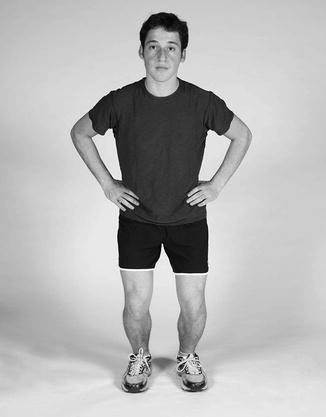

Fig. 2.2
Athletic ready position. Reproduced with permission from “The ACL Solution: Prevention and Recovery for Sports’ Most Devastating Knee Injury”. Marx, Myklebust & Boyle, Demos Publishing 2012
After mastering double-leg jumps and lands, it is time to progress to single-limb hop-and-hold exercises. This motion is comparable to mechanisms that cause non-contact ACL injuries. As the athlete improves, she will be advised to land with deeper knee flexion. Finally drills involving unanticipated cutting (Fig. 2.3) are important since valgus loads are doubled with these motions. Teaching and practicing these skills may carry over to real-time game situations as they become a learned movement response [2].
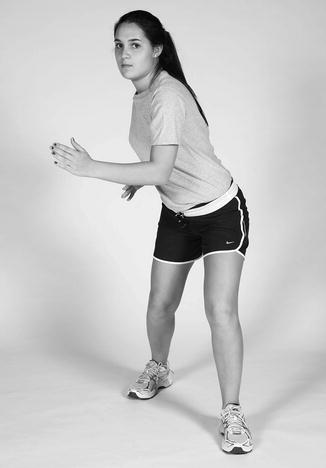

Fig. 2.3
Running and cutting. Reproduced with permission from “The ACL Solution: Prevention and Recovery for Sports’ Most Devastating Knee Injury”. Marx, Myklebust & Boyle, Demos Publishing 2012
Quadriceps Dominance: Identification
Quadriceps dominance can be defined as an imbalance between strength, recruitment, and coordination of quadriceps and hamstrings [6]. Hamstring to quadriceps isokinetic strength ratio <55–60 % indicates quadriceps dominance. Another test that may indicate quadriceps dominance is single-leg hop-and-hold in deep squat (>90°). If the athlete is unable to maintain deep flexion or maintain upright posture, there may be less than optimal hamstring firing [2].
Quadriceps Dominance: Treatment
It is important to address strengthening of the posterior chain (gluteals, hamstring, and gastrocnemius) to prevent improper, low flexion angle form instance, landing and cutting [8]. Drills using squat jumps and broad jump and hold assist in hamstring co-contraction training for stabilization in static positions [2]. Also exercises such as plyometric 90/90 squat jumps (Fig. 2.4a, b), Russian hamstring curls (resistance band around trunk for concentric and eccentric loading), ball bridge curls (double- to single-leg progression) and plank are appropriate for activation of hamstring and abdominal stability [8] (Fig. 2.5a, b).
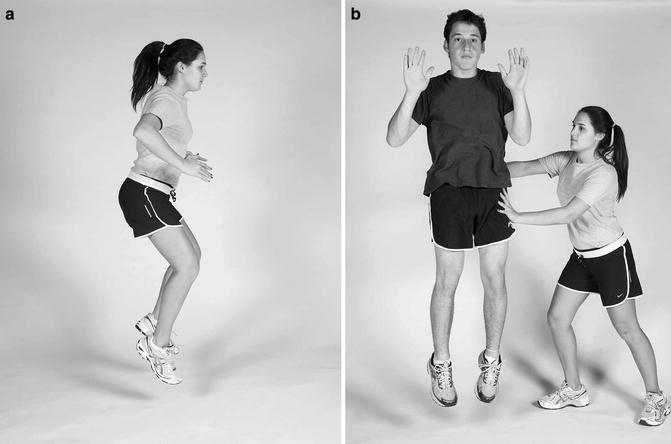
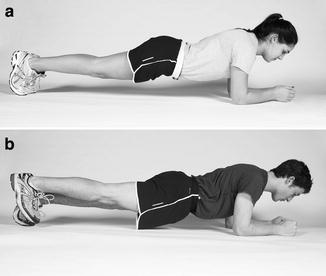

Fig. 2.4
(a) Box jumps (side-to-side, front-to-back, and along both diagonals). (b) Box jumps with Partner’s push. Reproduced with permission from “The ACL Solution: Prevention and Recovery for Sports’ Most Devastating Knee Injury”. Marx, Myklebust & Boyle, Demos Publishing 2012

Fig. 2.5
(a) Thirty second plank. (b) Thirty second plank with one leg lift. Reproduced with permission from “The ACL Solution: Prevention and Recovery for Sports’ Most Devastating Knee Injury”. Marx, Myklebust & Boyle, Demos Publishing 2012
Carcia et al. [12] noted a gait deviation called “gluteus maximus lurch” in which there is significant gluteus maximus weakness. This deviation demonstrates increased trunk extension at heelstrike and center of mass moves posterior to the hip. This will cause inhibition of gluteus maximus, minimizing hip extension activation [12].
Activation of gluteus medius and maximus is important to diminish hip internal rotation and adduction during landing, and overall knee valgus loading forces. Suggested exercises to improve gluteal function were side-lying clam, side-lying hip abduction, single-limb squat, single-limb dead-lift, lateral band walks, multiplanar lunges (Fig. 2.6), and multiplanar hops. The gluteus medius functions concentrically to abduct the hip, eccentrically to control hip adduction and internal rotation, and acts to stabilize the pelvis. Ideal gluteus medius exercises included sidelying hip abduction, single-limb squats (Fig. 2.7), lateral band walk, single-limb dead-lift, and single-limb side hop (Fig. 2.8). Gluteus maximus was shown to have the highest activation with the transverse plane lunge, single-limb squat, and single-limb deadlift [13].
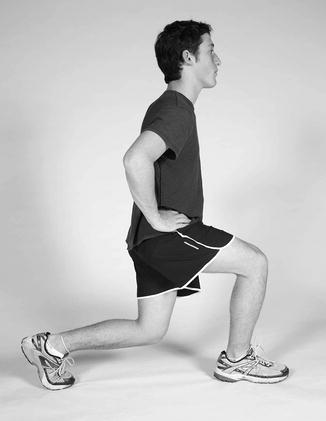

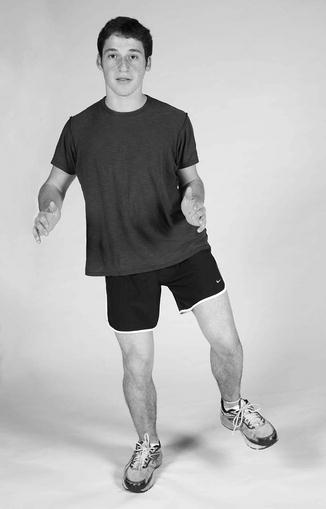

Fig. 2.6
Walking lunges. Reproduced with permission from “The ACL Solution: Prevention and Recovery for Sports’ Most Devastating Knee Injury”. Marx, Myklebust & Boyle, Demos Publishing 2012

Fig. 2.7
One-leg squats on wobble-board. Reproduced with permission from “The ACL Solution: Prevention and Recovery for Sports’ Most Devastating Knee Injury”. Marx, Myklebust & Boyle, Demos Publishing 2012

Fig. 2.8
Lateral jumps. Reproduced with permission from “The ACL Solution: Prevention and Recovery for Sports’ Most Devastating Knee Injury”. Marx, Myklebust & Boyle, Demos Publishing 2012
Leg Dominance: Identification
Leg dominance is a neuromuscular imbalance indicated by asymmetrical strength or power (difference of 20 % or more) between limbs. This may be assessed by performance of single-limb stance on an unstable platform allowing postural sway to be calculated. Another way to assess leg dominance is by utilization of single-limb hops, where an athlete hops into different quadrants [2].
Leg Dominance: Treatment
When addressing leg dominance deficits, it is important to start activities with double-leg before single-leg activity. It is important to maintain equal strength, balance, and foot placement between legs. For example, allowing one leg to land posterior will foster poor and unsafe habits when landing from a double-leg hop. Single-leg exercises, such as hop-and-hold or single-limb balance on unstable surfaces can help address improper landing or overuse of dominant leg. Bounding will assist in learning movement in multiplanar directions and achieve maximal vertical height and horizontal distance with each repetition [2]. When both lower extremities are alternately used in single-limb activities, there is a cross-over effect. Single-limb hopping may also influence recruitment of the posterior chain musculature, therefore assisting in reduction of quadriceps dominance as well.
Trunk Dominance: Identification
The most difficult imbalance to detect is trunk dominance during dynamic function. Performing a ball bridge with hamstring curl may assist in identifying pelvic instability by demonstrating rotation or anterior/posterior (AP) pelvic tilt during task completion in the transverse and frontal planes. Assessment of hip external rotation strength may also be a good predictor of future injury since that acts as a main stabilizer of the core and lower extremities [8].
Trunk Dominance: Treatment
It is important that the focus is not directed to the rectus abdominus, but rather to the deep musculature of the core: transverse abdominus and multifidus. One way to address rotational hip strength in a closed kinetic chain is by using a resistance band to work concentric and eccentric rotational motion while on one leg. This rotational motion is an example of pelvic rotation on the femur. It is important to cue the patient and provide appropriate feedback to prevent pelvic drop in the frontal plane or pelvic tilting in the sagittal plane [12].









